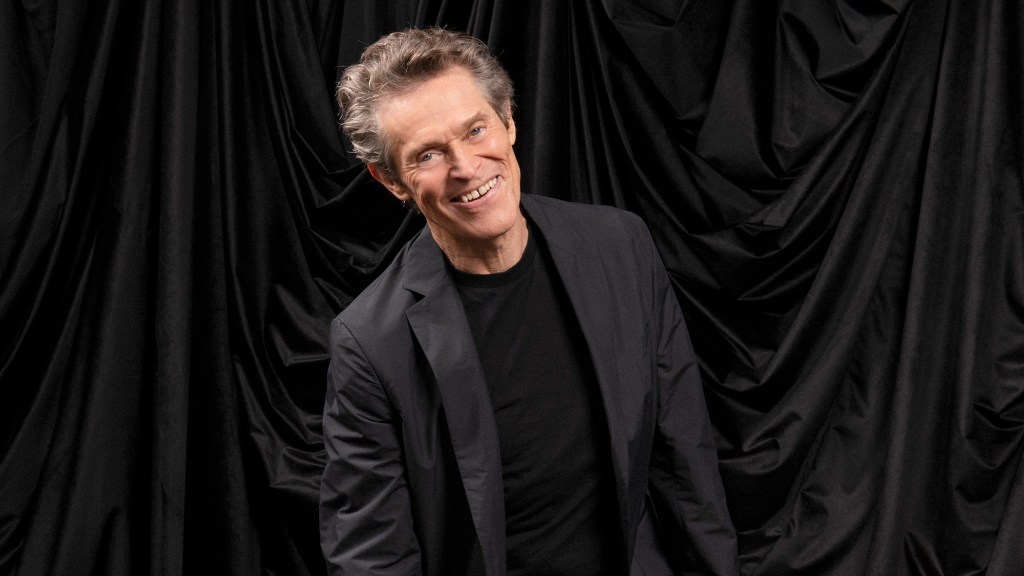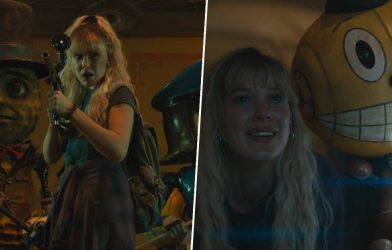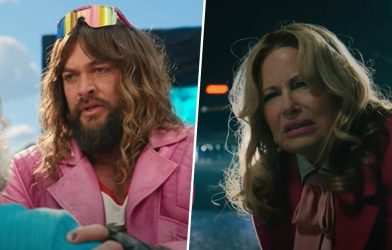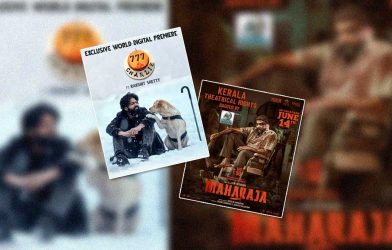
Willem Dafoe
Courtesy of Owen Kolasinski/Academy Museum Foundation via Getty Images
Is there a harder-working actor in the movie business than Willem Dafoe? The 68-year-old, who splits his time between Los Angeles, New York and Rome, has appeared in more than 150 films, co-starring in everything from superhero features to dozens of movie-buff favorites from David Lynch, Martin Scorsese, Lars von Trier, Paul Schrader, Oliver Stone, Julian Schnabel, Wes Anderson, Sean Baker, Spike Lee, Robert Eggers and so many more.
Fresh from his acclaimed performance in Yorgos Lanthimos‘ recent awards season favorite Poor Things, Dafoe is already returning to Cannes this month in the Greek director’s much-buzzed-about follow-up, Kinds of Kindness. Described as a surrealist fable set in the present day, the new project is an anthology film told in three parts, reuniting Lanthimos with the provocative screenwriting partner of his early career, Efthymis Filippou (Dogtooth, The Lobster, The Killing of a Sacred Deer). The film’s multi-Oscar-feted key cast — Dafoe, Emma Stone, Jesse Plemons, Margaret Qualley and Hong Chau — each play multiple characters across Kinds of Kindness‘ thematically interlaced stories.
Ahead of the start of the 2024 Cannes festival, THR connected with Dafoe to discuss working within Lanthimos’ unique worlds, the passion that keeps him on film sets almost constantly, and the skimpy but inspired costume contribution he made to the new feature.
Not much is known about Kinds of Kindness yet, other than that it’s a triptych. What was it like performing in a film with that structure?
It was really like making three films. It’s a very interesting film and I’m eager to see it again. [Lanthimos] makes stories where, for an actor, he gives you interesting things to do that maybe turn on certain situations or approach certain emotions, but they’re certainly not recognizable. As an audience member, when I watch his work, I feel that he transposes things. You have these feelings, but you don’t recognize the story — so you have new insights. You’re freed from conditioning. I find his work really stimulating and challenging — and fun.
He’s such a master of peculiar tones. What’s it like as an actor to exist within those tones?
Yes, he’s a very keen watcher. He’s very clear about the situations he puts you in, but he’s not clear about how he feels about them. It’s really through putting the material on its feet that he comes to some kind of understanding. So, as an actor, that’s fun. You’re always committing yourself to the actions at hand, but you always have this sense that either he hasn’t told you what to think or he hasn’t told you what to accomplish. He only wants you to be present and to be there for what you’re doing. And I like that.
That’s an interesting mix of freedom and control, which is what his films are often about, to an extent.
Certainly, those are big themes for him.

Margaret Qualley, Jesse Plemons and Willem Dafoe in Yorgos Lanthimos’ ‘Kinds of Kindness’
Courtesy of Searchlight Pictures
On the topic of costume, I heard that you wear a rather arresting orange Speedo in one segment and that the piece was your idea.
Well, it wasn’t much of an idea. (Laughs.) But you always want to amuse him, you know? Also, this character is very particular, and you just look for those things that turn you on and make it very specific and take you away from yourself. In my life, I didn’t think I would ever wear an orange Speedo on the beach, but in this story, I did it with pleasure.
Yorgos’s sets, for all the strangeness within his work, are famous for their playful, positive atmosphere. Did the unique structure and recurring character dynamics of this project feed into that sense of camaraderie between the actors?
One thing that Yorgos really accomplishes is camaraderie. Before we start shooting, we have some kind of rehearsal. And it’s not to unpack or interpret or talk about the actual scenes. In fact, we may not even address the dialogue or the actions at all. We’ll just do theater games and things to get to know each other. And that helps a great deal. It creates a company. It’s just a reflection of his personality and the people he has around him — a playfulness.
What’s your interpretation of the title, Kinds of Kindness?
I think it’s ironic — and to say more would give things away. Because these are almost surreal situations and the behavior of the people isn’t always what we would necessarily describe as kind. (Laughs)
From what I understand, this film was shot relatively quickly and entirely on location with a present-day setting. I imagine that must have been a bit freeing, or at least a little easier on the actors, after the exhaustive hair, makeup and costuming requirements of Poor Things?
Well, it wasn’t so exhausting on Poor Things. It’s work, but it’s a nice preparation. When a story deals with the contemporary world, there are so many recognizable things around you, that it’s sometimes hard to identify exactly what you’re doing. But when the world is more specific and surreal, it can actually be a little easier to enter. But I will say that while with Poor Things some of the abstractness and radical aesthetics are in the design, those qualities still exist in Kinds of Kindness — it’s just much more muted, and it’s much more the story that is the site of what’s aesthetically radical about the film.
Your creative output is pretty staggering. How would you describe your relationship with work?
It’s quite simple. Work is where I find pleasure and where I get to exercise my curiosities. I’m a guy that had worked with the same group of people in a theatre company for 27 years. I just like getting a group of people together and making things — things that reflect our experience and things that possibly try to see things not as they are but as they could be. This is an engagement that is sometimes hard to find in life. It’s heightened when you work, because the stakes are different. And the rules are different. So I enjoy so much being on set. I enjoy that social dynamic of collaboration, because the nature of film and theatre is so collaborative. Nobody does just one thing and your job is always different. What you do is always different because it’s a reflection of where you are and your relationship to other people. So I find that every time you do a project, you’re not so much taking inventory as you’re reorienting yourself and entertaining a different set of thoughts, impulses and conditions, as dictated by the people you’re working with.
The goofy explanation is that it’s an adventure. The more serious one is that it’s an engagement with and an appreciation of the complexity of our experience. It’s a way to connect us, because that’s essentially, I think, what’s the most important thing about culture and about film: that it makes us remember our connection. Film is one place where you really come together — and there’s a dependency and fluidity that not only nurtures you but also challenges you.
By extension, we’re taking this movie to Cannes. Cannes looks to be very exciting this year. I see the lineup and there are many directors I’ve worked with, many whom I admire, and some I don’t yet know. But the beauty of a film festival is that it really ups the discourse. The market aspect is also very important, because it brings to light certain films that may not get the proper assessment in only the cold glare of the marketplace. And that’s important, because we’re not going to advance the art and challenger ourselves if it’s only left to catering to what people want. That has to be pushed. As a viewer and as an actor, I like to go places where you’re seeing new things. In so much of our modern world, because of the internet, we’re given a passport to go wherever you want, but our feet — intellectually, emotionally, culturally, socially — aren’t put to the fire very often. In the festival environment, you have a wide range of experience. Many points of view are expressed, and a range of experiments and aesthetics are put forward. I just love it.
Do you know how many times you’ve been to Cannes? I was trying to piece it together, but you’ve made so many films that it’s pretty difficult
If I really thought about it, I could probably tell you. Quite a few times. I was on the jury once. I’ve had films in the main competition a few times. I’ve had things in sidebar sections. And a few times I’ve been there just for — for lack of better word — let’s say business.
Do you have any special Cannes memories that come to mind?
Oh, I have so many! It’s where you sometimes meet people and make new alliances that result in films. You see a film that attracts you to someone, and then you eventually come together to make something with them. All of those things have really happened to me. Then you’ll just have personal little things. I made a film with Paul Auster called Lulu on the Bridge. Salman Rushdie was supposed to play the role of a psychologist who psychoanalyzes Harvey Keitel during very long sequences in the movie. But this was a low-budget movie and the fatwa that Salman was living under was still in place. And the bond company eventually said the film couldn’t have Salman do it because of the security and liability that would be involved. They tried to negotiate, but it just wouldn’t work, so Salman had to drop out at the last minute. So Paul asked me to take the part with two days’ notice. I like Paul a great deal, so I agreed to do it. I’m telling you all of this because the film then went to Cannes, we had our big premiere, and then the next morning , when all of the trade dailies arrived at the hotel, let’s just say it was extremely clear that the film had not been warmly received by the critics. When this happens to you at Cannes, it can become very awkward. As you walk down the street, people almost kind of avoid you, because they don’t quite know what to say. But the thing that I’ll always remember is that I bumped into Pedro Almodovar later that day, and he was with a bunch of his actresses, and he was like, oh, please, come here! And he embraced us! And we all went on to have the most fun evening. So, what’s the point of that story? I guess it’s that I’ve been to Cannes with films that won the Palme D’or; others have done quite well, and some have really not done well. I know the A-to-Z of Cannes emotions — but it’s always such a pleasure to be there. And it’s very important to this art form that we all love.
Dafoe’s many Cannes connections
→ Dafoe’s first French film festival experience would prove a potent one. He made his debut walk down Cannes’ red carpet in 1990 in support of David Lynch’s surrealistic crime romance Wild at Heart, co-starring Nicolas Cage and Laura Dern. When that year’s jury president, Bernardo Bertolucci, awarded the film the Palme d’Or, the crowd reportedly reacted with as many jeers as cheers. Today, however, Wild at Heart’s cult classic status is secure.
→ Dafoe’s early Cannes streak continued in 1993 with his supporting part in Wim Wenders’ Faraway, So Close!, which won the Grand Prix du Jury, considered the festival’s second-highest honor. A sequel to Wenders’ now-classic Wings of Desire, Faraway, So Close! would go on to enjoy less critical and commercial success than its predecessor — but it had the exceedingly rare distinction of featuring cameos by both Lou Reed and former Soviet leader Mikhail Gorbachev.
→ Extracurricular business purposes brought Dafoe to Cannes in 1995. Here he’s seen catching a screening of Terence Davies’ competition entry The Neon Bible with his late pal Dennis Hopper, with whom he would soon appear in Julian Schnabel’s art world biopic Basquiat.
→ Dafoe made the trip to Cannes in 1998 in support of romantic mystery drama Lulu on the Bridge by novelist-turned-filmmaker Paul Auster (who died two weeks before this year’s festival). The film competed in Un Certain Regard and was savaged by the critics (see Q&A on page 24).
→ At the 2000 Cannes festival, Dafoe took part in a live interview event with Roger Ebert, who dissected the actor’s then 17-year career, which at that point spanned more than 40 films, including such highlights as The Last Temptation of Christ, Affliction, The English Patient and Platoon.
→ Dafoe made the first of several Cannes appearances in the company of Danish provocateur par excellence Lars von Trier in 2005 for Manderlay, co-starring a young Bryce Dallas Howard.
→ The actor was back in France the following year for a special Cannes Classics screening of his early career breakthrough, Platoon. The screening reunited Dafoe with director Oliver Stone and co-stars Charlie Sheen and Tom Berenger.
→ Arguably Dafoe’s most sensational Cannes moment came in 2009 with his co-starring performance opposite Charlotte Gainsbourg in von Trier’s Antichrist, which reportedly caused at least four people to faint during its press screenings because of its sequences of extreme violence. The film remains divisive but counts many film-world fans, among them John Waters, who once wrote in a review: “If Ingmar Bergman had committed suicide, gone to hell, and come back to earth to direct an exploitation/art film for drive-ins, [Antichrist] is the movie he would have made.”
→ In 2014, Dafoe reported for duty on Cannes’ main jury, serving alongside (from left) Nicolas Winding Refn, president Jane Campion, Gael García Bernal and Jia Zhangke. They awarded the Palme d’Or to Nuri Bilge Ceylan’s Winter Sleep.
→ Dafoe was back in victory lap mode in 2016 for a Cannes Classics screening of William Friedkin’s 1985 action thriller To Live and Die in L.A. Here he’s seen catching the premiere of Romanian director Cristian Mungiu’s Graduation.
→ One of Dafoe’s many recent Cannes turns came in 2019 with Abel Ferrara’s Tommaso, which featured a co-starring part played by the director’s young daughter Anna Ferrara. The film’s theatrical release was waylaid by the pandemic, but Dafoe was widely praised for his performance by those who saw it.









